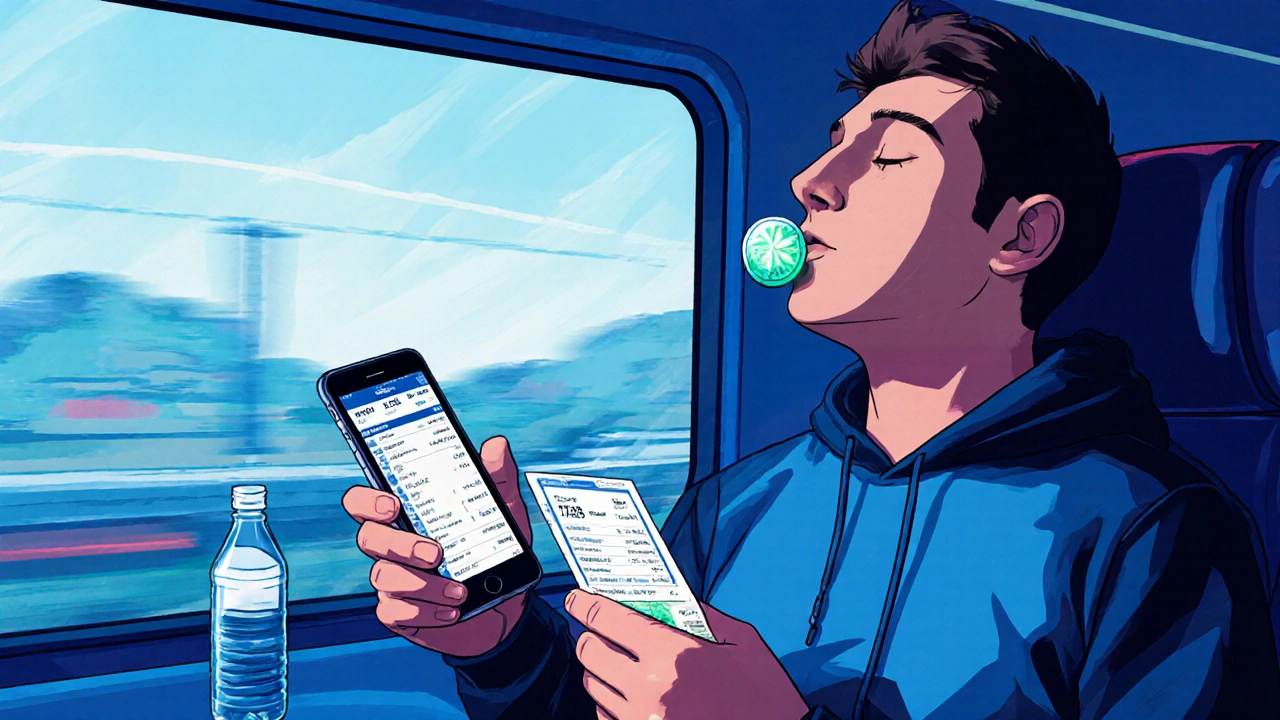Travel Sickness Effects on Athletes and Sports Fans
 Sep, 29 2025
Sep, 29 2025
Travel Sickness Risk Calculator
Assess your risk of experiencing travel sickness during trips based on key factors affecting athletes and sports enthusiasts.
Quick Take
- Travel sickness can shave minutes off an athlete's race time and lower endurance.
- Dehydration, vestibular disruption, and stress hormones are the main culprits.
- Hydration, vestibular training, and smart medication choices prevent most episodes.
- Adjust training schedules before long trips to keep performance steady.
- Seek medical advice if symptoms linger longer than 24hours.
Travel Sickness is a type of motion‑related nausea that occurs when the inner ear, eyes, and brain receive conflicting signals about movement. It commonly hits during air travel, bus rides, or boat trips, and the feeling can range from mild queasiness to full‑blown vomiting.
For Athlete is a person who trains regularly to compete in sports at a high level, the stakes are higher. A single bout of travel sickness can mean a missed warm‑up, a compromised race, or a lost training session.
Similarly, a Sports Enthusiast is someone who follows, supports, or participates in sports activities for enjoyment may find the experience dulling their enthusiasm and limiting participation in events that require travel.
Why Athletes Are Especially Vulnerable
Several physiological factors make athletes more prone to travel sickness:
- High Metabolic Rate - Intense training raises core temperature and oxygen demand, which amplifies the body’s stress response during motion.
- Dehydration - Even mild fluid loss impairs the Vestibular System is the inner‑ear apparatus that helps maintain balance and spatial orientation. When fluid levels drop, the inner ear fluid (endolymph) becomes less effective, heightening nausea.
- Pre‑competition Anxiety - The adrenaline surge before a big event can exacerbate gastrointestinal upset, making the stomach more sensitive to motion cues.
Symptoms That Directly Hit Performance
Typical signs include:
- Dizziness or a spinning sensation
- Nausea and occasional vomiting
- Headache and reduced concentration
- Fatigue that feels out of proportion to the effort
These symptoms drain energy reserves, decrease aerobic capacity, and mess with motor coordination-all critical for sprinting, cycling, rowing, or any sport that relies on steady power output.

Prevention Strategies That Actually Work
Below is a quick‑reference table that lines up the most common tactics, how they help, and when to apply them.
| Method | How it helps | Ideal timing |
|---|---|---|
| Strategic Hydration | Maintains inner‑ear fluid balance, reduces dizziness | Begin 24h before travel, sip electrolytes during trip |
| Vestibular Conditioning | Trains the brain to reconcile mismatched motion signals | d>Integrate balance drills 2-3times/week for 4weeks prior|
| Anti‑nausea Medication (e.g., meclizine) | Blocks histamine receptors that trigger nausea | Take 30min before boarding, follow dosage guidelines |
| Light, Low‑fat Meals | Prevents stomach overload, eases digestion | Eat a small snack 1-2h before travel; avoid heavy proteins |
| Acupressure Bands | Stimulates P6 point to curb nausea | Wear from boarding until arrival |
Combine at least two methods for best results. For example, pairing hydration with a short course of meclizine drastically lowers the odds of an episode during a 10‑hour flight.
Managing an Episode Mid‑Competition
If symptoms strike during a competition day, act fast:
- Find a quiet spot - Reduce visual motion cues by sitting still.
- Sip water or an electrolyte drink - Re‑hydrates the vestibular system.
- Take a quick anti‑nausea dose - If you’ve pre‑approved a medication, a 25mg tablet can calm things within 15minutes.
- Use controlled breathing - Inhale for 4seconds, hold for 2, exhale for 6. This lowers adrenaline and eases stomach muscles.
- Notify your coach - Adjust the warm‑up or event schedule if needed.
These steps often keep the athlete in the game without compromising safety.
Adjusting Training and Recovery Plans
Travel weeks require a tweak in the usual periodization model. Here’s a simple framework:
- Pre‑travel (3-5days) - Lighten load by 20%, focus on mobility and vestibular drills.
- Travel day - No high‑intensity work. Use the flight/bus time for gentle stretching and hydration.
- Post‑travel (1-2days) - Re‑introduce moderate cardio, monitor heart‑rate variability (HRV) for signs of lingering fatigue.
- Full‑intensity return - Resume normal programming once nausea is absent for 24hours and HRV is back to baseline.
Tracking symptoms in a simple log (time, fluid intake, meds taken) helps spot patterns and refine future travel plans.
When to Seek Medical Help
Most travel‑sickness cases resolve quickly, but see a professional if you experience any of the following:
- Vomiting that persists beyond 24hours
- Severe dehydration signs (dark urine, dizziness on standing)
- Chest pain or shortness of breath
- Recurring episodes despite preventive measures
A sports‑medicine physician can assess underlying vestibular disorders, prescribe stronger anti‑emetics, or suggest vestibular rehabilitation therapy.

Frequently Asked Questions
Can I take motion‑sickness medication before a race?
Yes, many athletes use a low dose of meclizine or dimenhydrinate an hour before travel. It’s best to test the medication during a low‑stakes training trip first, so you know how your body reacts.
How does dehydration worsen travel sickness?
Dehydration thins the fluid in the inner ear, making the vestibular system less accurate. The brain then receives mismatched signals, which triggers nausea. Staying hydrated keeps the fluid balance stable.
Are there any non‑drug options that work?
Absolutely. Acupressure bands, ginger chews, and specific vestibular training exercises (like head‑tilt rotations while seated) have proven effective for many athletes.
What’s the best timing for hydration before a flight?
Start sipping a balanced electrolyte drink at least 2hours before boarding, then take small sips every 15-20minutes during the flight. Aim for 1.5-2L total, adjusting for climate and personal sweat rate.
Should I skip warm‑ups if I feel a bit queasy?
A light, static warm‑up (e.g., gentle lunges, dynamic stretches) can actually help by stabilizing blood flow and calming the nervous system. Avoid high‑intensity bursts until the nausea subsides.
Albert Lopez
September 29, 2025 AT 21:39From a physiological perspective, the interplay between vestibular stress and aerobic demand suggests that athletes with elevated activity levels may experience exacerbated nausea during prolonged travel. The calculator’s weighting of activity level appears to lack a normalization factor for baseline fitness, thereby inflating risk scores for elite competitors. Moreover, the binary classification of hydration habits neglects osmotic balance, which is a critical determinant of motion‑induced gastrointestinal distress.
Halle Redick
October 1, 2025 AT 01:25Hey everyone, love that you’re thinking about staying healthy on the road! It’s super important to keep sipping water and maybe do a quick stretch before the trip. Even a little extra hydration can make a big difference for both fans and athletes.
don hammond
October 2, 2025 AT 05:12Oh great, another fancy calculator to tell you you’ll feel sick – because we all love being told what our bodies will betray us with. 🙄 If you’d rather trust your own gut, just bring a bag of pretzels and hope for the best 😂.
Ben Rudolph
October 3, 2025 AT 08:59Your calculator is as useless as a broken compass.
Jessica Di Giannantonio
October 4, 2025 AT 12:45Wow, this really hits home! Imagine the drama of an athlete feeling the world spin just as they’re about to sprint the final lap – pure cinematic thrill! Let’s all stay optimistic and keep those hydration packs ready for the grand finale.
RUCHIKA SHAH
October 5, 2025 AT 16:32Travel sickness is a real thing but staying calm and drinking water can help. Take it easy, breathe, and you’ll be fine.
Amy Collins
October 6, 2025 AT 20:19From a sports‑medicine standpoint, the synergistic effect of high‑intensity training and prolonged motion can precipitate neuro‑otological disturbances, especially when electrolyte balance is compromised. Leveraging periodization principles during travel can mitigate these risks.
amanda luize
October 8, 2025 AT 00:05Did you know the secret agencies are hiding a serum that eliminates motion‑sickness? It’s being withheld from athletes to keep the competition unpredictable. The colors in the code hint at a deeper agenda, a hidden pattern of control.
Chris Morgan
October 9, 2025 AT 03:52While many praise such tools, I maintain that reliance on an algorithm oversimplifies complex physiological variables. One must consider the stochastic nature of motion stress, not merely static inputs.
Pallavi G
October 10, 2025 AT 07:39Travel sickness is something many of us underestimate, especially when we’re excited for a big game or a marathon. First, it’s important to understand that the inner ear, which helps us balance, can be thrown off by constant motion, leading to nausea and dizziness. Second, athletes often push their bodies to the limit, and fatigue can worsen these symptoms, making it harder to enjoy the trip.
One practical tip is to schedule short, frequent breaks during long drives or flights, allowing the body a chance to reset. Hydration is another cornerstone; sipping water regularly, rather than gulping large amounts at once, keeps the blood volume stable and supports the vestibular system.
For those who travel with a high activity level, consider a light, protein‑rich snack before departure – it steadies blood sugar and reduces the risk of stomach upset. If you have a history of frequent motion sickness, over‑the‑counter remedies like meclizine can be taken an hour before travel, but always consult a medical professional first.
Finally, mental preparation helps: breathing exercises and focusing on a fixed point can ground the nervous system. By combining these strategies – regular hydration, balanced nutrition, strategic breaks, and mindfulness – athletes and fans alike can significantly lower their travel‑sickness risk and arrive ready to perform or cheer.
Rafael Lopez
October 11, 2025 AT 11:25Indeed, the comprehensive approach outlined above aligns with current sports‑science literature, which emphasizes a multimodal mitigation strategy. By integrating vestibular habituation protocols, optimizing electrolyte intake, and employing pre‑emptive pharmacologic interventions, one can attenuate the severity of travel‑induced malaise. Moreover, the timing of carbohydrate ingestion relative to departure is critical; a proportion of 30‑40 g of complex carbs administered 30 minutes prior has been shown to stabilize glycemic response, thereby reducing nausea incidence. In practice, athletes should therefore formulate a pre‑travel nutrition plan that incorporates both macro‑ and micronutrient considerations, ensuring adequate potassium and magnesium levels, which are essential for neuromuscular function.
Furthermore, the psychosomatic component cannot be overlooked. Visualization techniques, coupled with progressive muscle relaxation, have demonstrated efficacy in modulating autonomic output, thus diminishing vestibular sensitivity. It is also advisable to limit exposure to visual motion cues, such as reading or screen usage, during transit, as these can exacerbate sensory conflict.
In sum, a disciplined, evidence‑based regimen-encompassing hydration, nutrition, pharmacology, and mental conditioning-offers the most robust defense against travel sickness for athletes and enthusiasts alike.
Craig Mascarenhas
October 12, 2025 AT 15:12I cant trust that calculator, its probably a sneak in to monitor our health data for the elite sport brats. Theyre just feeding us more control while pretending we care about our gut. Some think its just a tool but its a trap.
aarsha jayan
October 13, 2025 AT 18:59Let’s keep the conversation welcoming – everyone’s experience matters. If you’ve found a tip that works for you, sharing it helps the whole community travel healthier and happier.